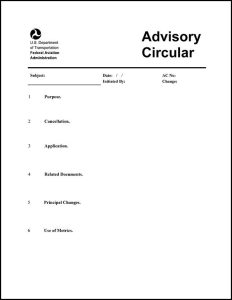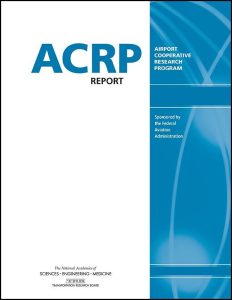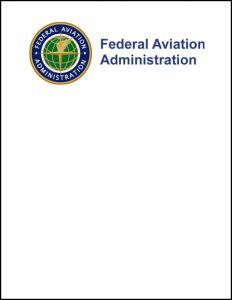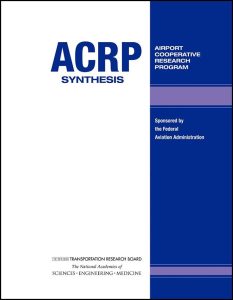To narrow the library of airside resources, use the filter boxes or airport map below or search box above.
Click an item below to expand.
Resources Matching Your Search
2017
This advisory circular (AC) provides guidance to airport owners and operators (sponsors) for Airport Improvement Program (AIP)-assisted projects to develop their land acquisition and relocation assistance procedures in conformance to the Uniform Relocation Act and its implementing regulations.
2013
ACRP Report 96 provides best practices for planning, designing, and marking apron areas for all sizes and types of airports in the United States. Apron planning and design considerations include facility geometrics, aircraft maneuvering, apron/airfield access points, operational characteristics, markings, lighting, and aircraft fleets. The report summarizes apron planning and design best practices for incorporating flexibility, increasing efficiency, and enhancing the safety of apron facilities.
2018
ACRP Research Report 184 is the executive summary of ACRP Web-Only Document 44: Understanding FAA Grant Assurance Obligations, Volume 1: Guidebook, and explains each of the 39 grant assurances. The summary includes a matrix that outlines major aspects of the program such as duration and applicability, and provides a list of related assurances. The matrix includes links to specific volumes of the web-only document that discuss each grant assurance in greater detail. Volume 2: Technical Appendices contains supplemental information, Volume 3: Research Report discusses the research effort, and Volume 4: Summary of AIP Grant Assurance Requirements includes a PowerPoint presentation for sharing content with airport manager, planners, and operators.
2018
ACRP Web-Only Document 44, Volume 1, provides a comprehensive summary of all the requirements included in the 39 Grant Assurances applicable to airport sponsors, who are owners or operators of the airport that execute the grant agreements. The web-only document describes the requirements, identifies the actions that are required and those that are prohibited, identifies exceptions, describes the duration and applicability of the requirements, and discusses the potential consequences of non-compliance.
2018
ACRP Web-Only Document 44 provides supplemental information for individuals desiring a more in-depth understanding of the requirements. It may be useful when airport management, staff, or airport users are confronted with a particular issue or a set of circumstances that is not fully addressed in ACRP Research Report 184. The web-only document contains six appendices providing supplemental information on the Grant Assurance requirements, as well as resources and references.
2018
ACRP Web-Only Document 44, Volume 3, summarizes the research efforts and results of the research conducted to develop a guidebook on FAA grant assurance requirements.
2018
ACRP Web-Only Document 44, Volume 4, is a model PowerPoint presentation for sharing content with airport managers, planners, and operators.
2020
This desk reference provides explanatory guidance for environmental impact analysis performed to comply with Council on Environmental Quality (CEQ) Regulations for Implementing the Procedural Provisions of the National Environmental Policy Act (CEQ Regulations) (40 Code of Federal Regulations (CFR) parts 1500-1508); U.S. Department of Transportation (DOT) Order 5610.1C, Procedures for Considering Environmental Impacts; and Federal Aviation Administration (FAA) Order 1050.1F Environmental Impacts: Policies and Procedures.
2019
This document provides a comprehensive approach to developing and implementing a security master plan. It is of relevance to airport management and staff as well as security consulting organizations. A security master plan enables an airport to systematically support the forecasting and planning of future security needs as well as the associated capital expenditures.
2016
ACRP Synthesis 77 compiles information about airport sustainability practices and adds them to the Sustainable Aviation Guidance Alliance (SAGA) website. The SAGA website was developed to help airport operators develop sustainability programs and provide guidelines to those who have new data to input. The website contains entries on more than 900 sustainability practices that were developed by SAGA's initial stakeholder group.
2018
ACRP Synthesis 93 compiles information and examples that successfully demonstrate the value of building sustainability concepts into capacity-enhancing projects. The report describes additional resources and tools that provide information on how to select, apply, and communicate sustainability measures. The report explores how sustainability efforts often build on themselves, how lessons learned from one initiative are carried through to the next, and how this progressive learning process can enhance sustainability's role in capacity-enhancing projects over time.
2019
This advisory circular (AC) provides information on community/public involvement in airport planning. This AC is intended to advise airport sponsors, planners, and the public on the benefits of early public participation in airport planning, and the methods by which this participation may be achieved.
2015
This advisory circular (AC) provides guidance for the preparation of master plans for airports that range in size and function, from small general aviation to large commercial service facilities. The intent of this AC is to foster a flexible approach to master planning that directs attention and resources to critical issues. The scope of each master plan must be tailored to the individual airport under evaluation.
2015
This advisory circular (AC) provides guidance for airport sponsors in the selection and engagement of architectural, engineering, and planning consultants. It also discusses services that normally would be included in an airport grant project, types of contracts for these services, contract format and provisions, and guidelines for determining the reasonableness of consultant fees.
2019
ACRP Report 16, second edition, is designed to help airport practitioners, owners, operators, managers, and policymakers of small airports, who may have varying degrees of experience and backgrounds, to fulfill their responsibilities in such areas as financial management, oversight of contracts and leases, safety and security, noise impacts, community relations, compliance with federal and state obligations, facility maintenance, and capital improvements. The first edition has been edited and reformatted for currency, relevance, and usability and updated with additional information and new subject areas (e.g., unmanned aircraft systems, geographic information systems, digital notices to airmen, social media, and federal and state obligations). Also, hyperlinks to many of the documents and resources mentioned in this report, such as ACRP publications, industry sources, and sample checklists, have been collected into ACRP WebResource 6: Resources for Managing Small Airports.
2019
ACRP Research Report 208 provides guidelines on using benefit–cost analysis (BCA) to identify, evaluate, and select airport stormwater management projects. Many airports undertake stormwater projects to accommodate facility expansion, address obsolescence, and respond to evolving regulatory requirements. Often, stormwater infrastructure is installed or upgraded on a project-by-project and piecemeal basis, resulting in mismatches of sizes, material types, ages, and conditions. When airports are considering expanding or improving their stormwater facilities, the immediate need for stormwater infrastructure modification may not be clear, and a BCA is needed. The report will be particularly helpful for small airports that may not have BCA expertise or experience with innovative stormwater projects.
2016
TRB recorded a series of videos in August 2016 on the planning and design of non-traditional airports. In this series, non-traditional airport refers to any airport that faces specific or unusual challenges due to its environment, traffic, location, or purpose, includes innovative features and technologies, or is involved in emerging operations. The videos cover three different airport case studies and an emerging issue for airports.
2013
TRB conducted a webinar that featured research conducted by ACRP about decision-making processes and tools for evaluating options for airport improvement projects, as well as assessment techniques for conducting benefit-costs analyses. The airline industry continually strives to achieve greater efficiencies and lower costs while also making improvements to facilities that may be nearing the end of their design lives or are becoming functionally obsolete. Effective capital planning is therefore needed. The presentations in this webinar provide information to assist industry decision-makers with airport improvement projects and highlight ACRP Report 68, ACRP Synthesis 25, and ACRP Synthesis 13.
2016
TRB conducted a webinar on a project conducted by ACRP that provided updated guidance on General Aviation (GA) facility planning in order to help airport practitioners plan GA facilities that are responsive to industry needs.
2016
TRB conducted a webinar that features research conducted by ACRP on how to use the Sustainable Aviation Guidance Alliance (SAGA) website to capture sustainability practices data, understand how renewable energy can add unique value to an airport's business, and identify a systematic process for evaluating whether renewable energy will meet an airport’s long-term goals and objectives. The webinar presenters also focused on how to maximize the benefits of renewable energy and sustainability practices by using business case evaluations.





